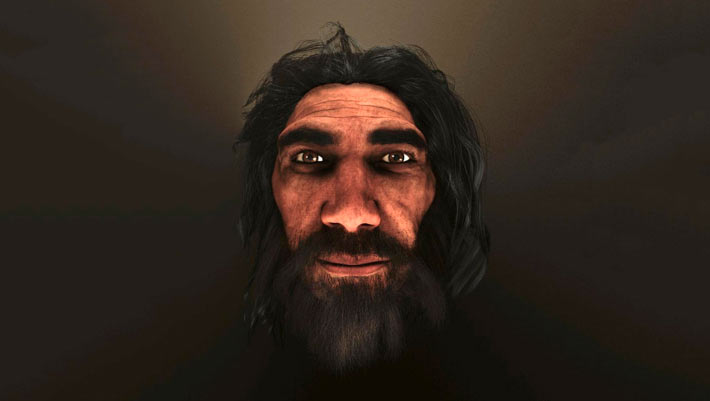Anthropologists in Greece have used facial reconstruction techniques to show how Homo heidelbergensis, a poorly understood relative of Neanderthals that lived between 700,000 to 200,000 years ago, might have once looked.

Frontal view of the portrait of Homo heidelbergensis from Petralona, Greece, with hair and skin pigmentation. Image credit: Aidonis et al., doi: 10.1016/j.jasrep.2023.104206.
Homo heidelbergensis is an extinct species of the genus Homo known from fossils dating from 700,000 to 200,000 years ago in Africa, Europe, and possibly Asia.
This species had a very large browridge, and a larger braincase and flatter face than older human species.
Homo heidelbergensis was the first early human species to live in colder climate. It had a short, wide body — likely an adaptation to conserving heat.
The species lived at the time of the oldest definite control of fire and was the first species to build shelters, creating simple dwellings out of wood and rock.
Homo heidelbergensis was also the first hunter of large animals. The fossilized bones of wild deer, horses, elephants, hippos, and rhinos with butchery marks have been found together at sites with Homo heidelbergensis fossils. Evidence for this also comes from wooden spears found at the site of Schöningen, Germany.
The name of Homo heidelbergensis first appeared in print in 1908 to accommodate an ancient human jaw discovered in 1907 in a quarry at Mauer, a village near Heidelberg, Germany.
However, the species has only become more accepted since the end of the 20th century with the discovery of additional fossils.
Among other examples of Homo heidelbergensis, the best are specimens from Bodo in Ethiopia, Kabwe in Zambia, Ndutu in Tanzania, Petralona in Greece, Arago in France, and possibly Dali in China.

Lateral view of the portrait of Homo heidelbergensis from Petralona, Greece, with hair and skin pigmentation. Image credit: Aidonis et al., doi: 10.1016/j.jasrep.2023.104206.
To reconstruct a face of the ancient species, Democritus University of Thrace anthropologist Christina Papageorgopoulou and her colleagues used the well-preserved skull from Petralona.
“The Petralona skull is one of the most anatomically complete human fossils of the Middle Pleistocene and a key paleoanthropological finding in Europe,” the researchers said.
“It was discovered in 1960 during an amateur exploration in Petralona Cave, Chalkidiki, Northern Greece.”
“The complex cave system, a result of transverse speleogenesis, is located in the western foothills of the limestone Mt. Katsika, about 300 m above sea level.”
The Petralona skull is currently housed in the Museum of Geology, Palaeontology and Paleoanthropology of the Aristotle University of Thessaloniki, Greece.
“According to its sexually dimorphic characteristics, it belongs to a man,” the scientists said.
“Cranial sutures closure indicates a young age, probably no older than 35 years. Body mass has been estimated to 52 kg.”
For the facial approximation of the Petralona man, they digitized a cast of the original skull with an Artec Spider 3D scanner.
“The facial skeleton of the Petralona skull is intact and undistorted. Slight deformation observed in the rear of the vault and the temporal bones does not affect the morphology of the face. However, the skull lacks the mandible,” they said.
Thus, for reconstructing the morphology of the face, the authors used the Mauer jaw, which is the so-called holotype specimen of Homo heidelbergensis.
“This fossil is one of the oldest recovered in Europe and has been dated to 609,000 years,” they explained.
“Its morphology aggregates primitive (wide ramus, massive body without mental eminence) and derived features (moderate size of the teeth).”
According to the team, the approximation of the Petralona man shows the characteristic sloped forehead, massive brow ridges and facial robusticity that are present in Homo heidelbergensis and differentiate them from Neanderthals and anatomically modern Homo sapiens.
“To our knowledge, the facial approximation of the Petralona man is the first hominin facial approximation implemented in paleoanthropological material from Greece,” the researchers said.
“Facial approximation techniques, especially when applied to archaic hominin present well known limitations. Despite this, facial approximation presents great potentials in the cultural, educational and scientific sectors.”
“In the era of information technology and with the technological advancement in the fields of medical imaging, geometric morphometrics, ancient DNA, 3D scanning, image processing and virtual reality, facial approximation may become a very useful tool for cultural heritage diffusion.”
The team’s paper appears in the Journal of Archaeological Science: Reports.
_____
Asterios Aidonis et al. 2023. Digital 3D facial approximation of the Petralona skull. Methodological issues and applications. Journal of Archaeological Science: Reports 51: 104206; doi: 10.1016/j.jasrep.2023.104206




